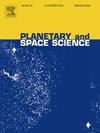金星Beta区羽流Theia Mons的地质历史:两个主要岩浆流中心的识别,辐射岩脉群和三重接合裂谷
IF 1.7
4区 物理与天体物理
Q3 ASTRONOMY & ASTROPHYSICS
引用次数: 0
摘要
Theia Mons(中心位于北纬23.4°,西经79.4°)是位于金星Beta- atla - themis (BAT)区域的Beta区域羽流的主要火山中心。合成孔径雷达数据(SAR)和1989-1994年美国宇航局麦哲伦任务的高程数据被用来绘制泰亚山的地质图和历史,揭示了两个不同的岩浆中心(相距200公里),每个中心都是玄武岩熔岩流的焦点,伸展的轮廓(代表岩脉群的表面表现),以及相关的裂谷带。研究区跨度为88°W ~ 72°W, 16°45′n ~ 29°45′n,作图比例尺为1:50万。我们详细的地图使该地区成为未来金星任务(轨道和着陆器)的主要目标,也考虑到贝塔地区是正在进行的火山活动的有力候选者。将属于Theia Mons火山的熔岩(玄武岩)流单元(根据雷达后向散射变化区分出88个)组合为19个flow group,再组合为3个flow package。熔岩流似乎从两个不同的岩浆中心发散出来,标记为中心1(24.5°N, 78.1°W)和中心2(23.4°N, 79.4°W),较老的中心1被较年轻的中心2的火山活动所掩盖。中心1由雷达亮度较低的气流组成,最大延伸至离中心830公里处。中心2与目前保存的中央火山口重合,由低雷达亮度的熔岩流组成,最大长度为620公里,其次是雷达亮度较低的第二脉冲流,其范围较小,集中在中心附近。绘制了约1万个伸展构造(地堑、裂缝和裂缝),并将其归类为19个系统,其中15个系统被解释为覆盖岩脉群;2个辐射系统与中心1和2有关,另外13个系统属于该地区其他(可能不相关的)岩浆中心。中心2也可能出现部分环状虫群。推断出另外四个张性线组代表与裂谷带相关的正断层组(Devana和Zverine,以及其他裂谷带)。这些裂谷带呈现出两套“三重交界处”的几何形状,它们也大致集中在熔岩流和裂谷带所显示的中心1和中心2上。下面的地幔柱被解释为岩脉、流动和三结裂陷的原因。中心1和中心2(向西南方向200公里)之间移动的原因尚不清楚,但可能的机制包括岩石圈板块在静止的单个地幔柱上方移动,或者在中心1和中心2活动的时间之间地幔柱的弯曲(例如在地幔风中)。本文章由计算机程序翻译,如有差异,请以英文原文为准。
Geological history of Theia Mons, Beta Regio plume, Venus: Recognition of two main magmatic centers for flows, radiating dyke swarms and triple junction rifting
Theia Mons (centered at 23.4° N, 79.4° W) is the main volcanic center for the Beta Regio plume, of the Beta-Atla-Themis (BAT) region, Venus. Synthetic aperture radar data (SAR) and altimetry data from the 1989–1994 NASA Magellan mission were used to produce a geological map and history of Theia Mons, revealing two distinct magmatic centers (200 km apart), each the focus of basaltic lava flows, extensional lineaments (representing the surface expression of dyke swarms), and associated rift zones. The study area spans 88°W to 72°W, 16°45′N to 29°45′N, and mapping was at 1:500,000 scale. Our detailed mapping makes this area a prime target for the future Venus missions (orbital and lander), also given that Beta Regio is a strong candidate for ongoing volcanic activity.
Lava (basaltic) flow units (88 distinguished on the basis of variation in radar backscatter) belonging to Theia Mons volcano were combined into 19 Flow Groups and then into 3 Flow Packages. The lava flows appear to diverge from two distinct magmatic centers, labelled Center 1 (24.5°N, 78.1°W) and Center 2 (23.4° N, 79.4°W), with the older Center 1 being obscured by the volcanism of the younger Center 2. Center 1 consists of flows with low radar brightness and which extend to a maximum to 830 km from the center. Center 2 coincides with the currently preserved central caldera and consists of lava flows of low radar brightness with a maximum length of 620 km, followed by a second pulse of radar-bright flows that are less extensive and concentrated near the center.
About 10,000 extensional lineaments (grabens, fissures, and fractures) were mapped and grouped into 19 systems, of which 15 are interpreted to overlie dyke swarms: 2 radiating systems are associated with Centers 1 and 2, and 13 other systems belong to other (older and likely unrelated) magmatic centers in the region. A partial circumferential swarm may also be present, associated with Center 2.
Four other extensional lineaments sets are inferred to represent sets of normal faults associated with rift zones (Devana and Zverine, and additional rift zones). These rift zones exhibit two sets of ‘triple junction’ geometry, which are approximately also focussed on the same Centers 1 and 2, revealed by the lava flows and rift zones.
An underlying mantle plume is interpreted to be responsible for the dykes, flows and triple junction rifting. The cause of the shift between Centers 1 and 2 (200 km to SW) is unknown, but plausible mechanisms include a shift of the lithospheric plate above a stationary single plume, or a bending of the mantle plume (e.g. in a mantle wind) between timing of Center 1 and Center 2 activity.
求助全文
通过发布文献求助,成功后即可免费获取论文全文。
去求助
来源期刊

Planetary and Space Science
地学天文-天文与天体物理
CiteScore
5.40
自引率
4.20%
发文量
126
审稿时长
15 weeks
期刊介绍:
Planetary and Space Science publishes original articles as well as short communications (letters). Ground-based and space-borne instrumentation and laboratory simulation of solar system processes are included. The following fields of planetary and solar system research are covered:
• Celestial mechanics, including dynamical evolution of the solar system, gravitational captures and resonances, relativistic effects, tracking and dynamics
• Cosmochemistry and origin, including all aspects of the formation and initial physical and chemical evolution of the solar system
• Terrestrial planets and satellites, including the physics of the interiors, geology and morphology of the surfaces, tectonics, mineralogy and dating
• Outer planets and satellites, including formation and evolution, remote sensing at all wavelengths and in situ measurements
• Planetary atmospheres, including formation and evolution, circulation and meteorology, boundary layers, remote sensing and laboratory simulation
• Planetary magnetospheres and ionospheres, including origin of magnetic fields, magnetospheric plasma and radiation belts, and their interaction with the sun, the solar wind and satellites
• Small bodies, dust and rings, including asteroids, comets and zodiacal light and their interaction with the solar radiation and the solar wind
• Exobiology, including origin of life, detection of planetary ecosystems and pre-biological phenomena in the solar system and laboratory simulations
• Extrasolar systems, including the detection and/or the detectability of exoplanets and planetary systems, their formation and evolution, the physical and chemical properties of the exoplanets
• History of planetary and space research
 求助内容:
求助内容: 应助结果提醒方式:
应助结果提醒方式:


